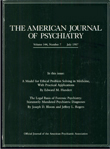What happens to children with psychiatric disorders as they grow up? Do they grow out of it as the title asks? The importance of this book lies in both the critical questions it addresses and the concise, scientific nature of its answers.
Some of the foremost experts in their fields present data on outcomes of childhood attention deficit hyperactivity disorder (ADHD), comorbidity with ADHD, conduct disorder, depression, suicidal behavior, anxiety disorders, obsessive-compulsive disorder, pervasive developmental disorder, and speech and language disorders. The authors look at the factors that influence outcome, including several therapies, medications, developmental factors, and social factors. The answer to the title's question about outcomes, of course, varies for each disorder and according to risk factors.
Framed by chapters on research issues and clinical implications of longitudinal research, the text abounds with descriptions of outcome studies, generally including the research designs. Although the copious data and the disparate styles of the authors make the text somewhat dense and disjointed, they also make for an exceptional reference.
The book's extensive data on outcomes will prove an essential resource to the clinician in guiding clinical decisions. By understanding the relative importance of risk factors and diagnoses to outcome, the clinician can better establish priorities for treatments. For example, in “Suicidal Behavior,” Cynthia Pfeffer describes substance use as a leading risk factor for completed suicide in depressed children, increasing the risk of suicide fourfold. This information would lead a clinician to focus on substance use issues in a depressed child.
The book also offers information that will be important in helping families and children understand the course of illness. For example, in “Childhood Anxiety Disorders,” Diane Maj~cher and Mark Pollack report data indicating that children under 11 years old are three times more vulnerable to posttraumatic stress disorder (PTSD) than older children and that 60% of children exposed to a sniper had PTSD symptoms a month later. Such information can help normalize early PTSD symptoms after acute trauma in young children.
In the final chapter, “Clinical Issues in Longitudinal Research,” Gabrielle Weiss presents colorful vignettes of children with ADHD followed for 15 years. The choice of professions and of mates helped these children grow into successful adults and cope with their illnesses. In describing Weiss's vignettes in the preface, the editor says, “These histories leave an indelible picture of people struggling courageously and creatively to adapt and succeed despite adversities. They teach all of us the true meaning of long-term outcome of childhood disorders” (p. xv). By ending with these vignettes, Hechtman leads the reader to contemplate the natural next question: How do some children grow out of it?

